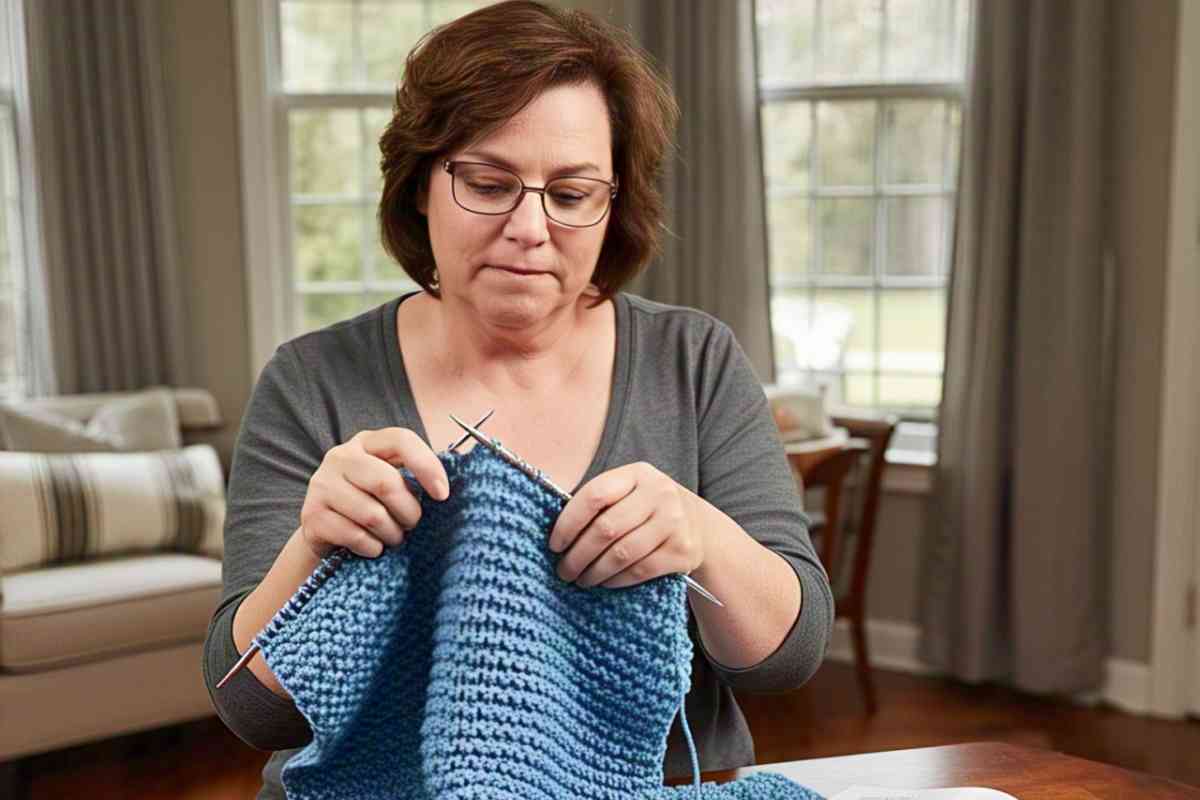How to Knit a Weighted Blanket?

Looking for a cozy, custom way to relax? Knitting your own weighted blanket lets you create something soft, soothing, and made just for you.
It’s easier than you think, and worth every stitch. In this guide, you’ll learn how to choose materials, pick the right weight, and knit a blanket that feels just right.
Key Takeaways
Choose the Right Materials: Use chunky, breathable yarn and even-weight fillers like glass beads.
Match the Weight to Your Needs: Aim for about 10% of the user’s body weight for comfort and safety.
Keep It Simple to Start: Use beginner-friendly stitches like garter stitch if you’re new to knitting.
Distribute Weight Evenly: Space your filler consistently to avoid lumps and ensure a balanced feel.
- Care for It Properly: Wash gently, lay flat to dry, and avoid stretching to maintain shape and softness.

Why Knit Your Own Weighted Blanket?
Knitting your own weighted blanket lets you customize the weight, size, and texture to your exact preference.
It’s a satisfying DIY project that also saves money. Plus, the repetitive motion of knitting can calm your mind and offer real therapeutic value.
Determining the Ideal Weight for Your Knitted Blanket
- Start with 10% of Body Weight for the Ideal Blanket: Begin by using a simple guideline: aim for 10% of the user’s body weight. For example, a person who weighs 150 pounds should look for a 15-pound blanket.
- Personal Preferences Can Change the Weight: People may prefer a heavier blanket, or certain conditions like restless legs syndrome might make a weightier blanket more comfortable.
Summary
Guideline: Aim for 10% of your body weight (e.g., 150 lbs = 15 lbs blanket).
Personal Preference: Heavier blankets may be preferred for comfort or conditions like restless legs syndrome.
Caution: Don’t go too heavy, as it may feel overwhelming. Always prioritize comfort over weight.
Who Can Benefit From a Knitted Weighted Blanket?
- Stress Relief for Adults: Knitted weighted blankets help adults reduce stress and anxiety , making them feel calmer and sleep better by offering gentle, consistent pressure.
- Comfort for Children with Anxiety: For children, particularly those who struggle to relax or experience anxiety, the soothing weight of a knitted blanket can help them feel secure and comfortable, making it easier to fall asleep.
- Better Sleep for Seniors: Seniors who use knitted weighted blankets often find that they experience better sleep and reduced muscle tension, leading to more restful nights and a sense of relaxation.
- Calming Effects for People with ADHD, Autism, or PTSD: People with ADHD , autism, or PTSD benefit from the calming effect of the weighted blanket, helping them feel more grounded and less anxious, which supports better sleep and emotional stability.

How to Knit a Weighted Blanket?
Choose Yarn and Materials That Work for Weighted Blankets
- he yarn should feel soft and still be strong: When you're making a weighted blanket, the yarn should be soft to touch but also strong enough to hold the blanket together for a long time.
- Cotton or bamboo yarns are better for your skin: Natural fibers like cotton or bamboo let the blanket breathe and feel gentle on your skin, which is great if you use the blanket for long hours.
- Eco-friendly yarns avoid plastic and still feel nice: If you care about the environment, go for organic cotton yarn. It skips plastic fillers and still gives you a soft, safe, and natural feel.
- Synthetic yarns are cheaper but can trap heat: Man-made yarns are tough and budget-friendly, but they don’t let air through well, which can make the blanket feel hot and less comfy.
- Thick yarn makes the blanket warmer and cozier: Using chunky or bulky yarn adds extra warmth and makes the blanket feel soft and snuggly, perfect for a cozy night in.
- Using two yarn strands adds weight without fillers: Instead of loading the blanket with beads or pellets, you can double the yarn strands to make the blanket heavy in a more natural way.
Figure Out the Right Weight and Size for Your Needs
- Make sure your blanket fits your bed or couch properly: To get the most comfort, your weighted blanket should be close to the size of your bed or the couch you’ll use it on. It’s best if it doesn’t hang off the sides too much, so it stays in place.
- Use common blanket sizes to pick what’s right for you: Following standard sizes helps avoid mistakes. A twin weighted blanket is usually about 65–66" x 90", while queen sizes often go from 90" x 90" up to 100".
- Change the yarn or filler if the blanket feels too heavy or light: If your blanket doesn’t feel right, it’s easy to fix. You can adjust how thick the yarn is or how much filler you use to get the perfect weight for your comfort.
- Get both the size and weight just right for your body: Finding a balance between how big and how heavy the blanket is makes a huge difference. When both are matched to your needs, your blanket feels just right every time you use it.
Pick a Knitting Method That Matches Your Skill Level
- Start with a method that feels simple and doable: Begin with the garter stitch , which is one of the easiest knitting styles. It’s simple to learn, gives your blanket a nice textured look, and helps you get comfortable with the process.
- As you feel more confident, try something a little more advanced: Once you’re used to the basics, you can move on to more interesting patterns like stockinette or seed stitch . They give your blanket a stylish twist without being too hard to learn.
Distribute the Weight Evenly as You Knit
- Check Filler Balance Regularly: Ensure the filler is evenly distributed by checking it frequently. This helps maintain an even weight throughout the blanket.
- Use Pouches for Even Weight Distribution: Using small pouches filled with beads helps spread the weight evenly, preventing lumps and making sure the blanket feels smooth.
- Take Your Time for Even Weighting: Carefully spread the weight as you knit. Taking your time will make sure the blanket is smooth, comfortable, and evenly weighted.
Start Knitting the Blanket, Row by Row
Start by casting on the appropriate number of stitches for your desired width. Keep your tension even and your stitches consistent to create a uniform blanket.
Count your stitches at the end of each row to avoid mistakes. As you knit, be mindful of adding weight evenly.
Bind Off Carefully and Secure All Loose Ends
-
Bind Off to Prevent Loose Edges: When finishing, bind off your blanket carefully to prevent loose edges that could unravel over time.
-
Use the Basic Knit Bind-Off for Heavier Blankets: Use the basic knit bind-off method, which is perfect for heavier blankets, ensuring it stays intact.
- Weave in Loose Ends to Keep It Secure: Make sure to properly weave in all loose ends, especially where the blanket’s weight is incorporated, to keep everything secure.
Test for Comfort and Make Sure It’s Durable
- Ensure the Fabric Feels Soft for Comfort: Once your blanket is ready, make sure the fabric feels soft to the touch for maximum comfort.
- Secure the Stitching for Durability: Check that the stitching is secure to prevent it from unraveling, ensuring the blanket lasts longer.
- Test the Blanket by Using It for Comfort: Use the blanket for a few nights to see if it provides the comfort and support you need for a good night’s sleep .
- Wash Gently to Preserve Softness: Wash the blanket using a gentle cycle with mild detergent to preserve its softness and comfort.
- Lay Flat to Dry and Maintain Shape: Always lay the blanket flat to dry, which helps maintain its shape and prevents any stretching.
Summary
To knit a weighted blanket, choose soft, breathable yarn like cotton or bamboo, and ensure the right weight and size. Pick an easy knitting method, evenly distribute the weight, and finish with secure edges. Test for comfort and durability, then wash gently for lasting coziness.

Option |
Good |
Better |
Best |
Yarn |
Cotton |
Bamboo |
Chunky Wool |
Filling |
Polyester Beads |
Glass Beads |
Steel Beads |
Knitting Method |
Garter Stitch |
Stockinette |
Seed Stitch |
How to Properly Wash and Care for a Knitted Weighted Blanket?
- Follow the Care Instructions for Your Blanket’s Material: To keep your knitted weighted blanket looking and feeling great, always follow the care instructions specific to the yarn and filling used.
- Machine Wash on Gentle Cycle with Cold Water: Most blankets can be machine washed on a gentle cycle with cold water, making it easy to clean without damaging the fabric.
- Handle Chunky Knit Blankets Gently: Chunky knit blankets require extra care since they can stretch easily. Lay them flat to dry and avoid wringing or hanging to preserve their shape.
- Pre-Treat Stains with Mild Detergent: Before washing, gently treat any stains with a mild detergent to protect the fabric and help keep the blanket looking fresh.
FAQs
Can I use recycled or upcycled materials to knit a weighted blanket?
Absolutely. You can use recycled yarn, fabric strips, or even old T-shirts cut into yarn. Just make sure the materials are clean and strong enough to withstand regular use.
What should I do if I make a mistake while knitting a weighted blanket?
Don’t panic! Everyone drops a stitch or miscounts sometimes. Use a crochet hook or knitting needle to fix the stitch. You don’t have to start over, just adjust the stitch count by carefully adding or removing stitches as needed.
How long does it typically take to knit a weighted blanket by hand?
Knitting a weighted blanket by hand typically takes 30 to 60 hours, depending on your speed and the design's complexity. For a 50x60 inch blanket, plan on 50-60 hours, especially with thicker yarn or added details. Beginners may take longer. A practical timeline is 2 to 4 weeks, knitting 8–10 hours per week. Staying consistent will help you finish on schedule.
Are there safety considerations when knitting a weighted blanket for children or pets?
Yes. For children, the blanket should be about 10% of their body weight to avoid restricting movement. Choose breathable, hypoallergenic fabrics and avoid using small beads or items that could be a choking hazard. Always supervise young children during use.




